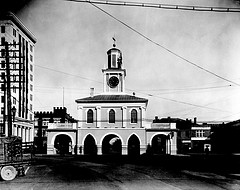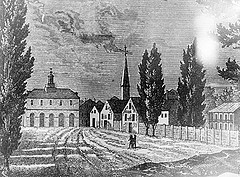Market Houses
 Markets in colonial North Carolina were a
Markets in colonial North Carolina were a  part of the English tradition brought by early settlers. As early as the thirteenth century town markets in England offered opportunities to buy and sell. North Carolina's first town, Bath (chartered in 1705), had a town common where fairs and markets were held. In the 1720s the colonial Assembly passed acts to create marketplaces in towns, and in 1731 Governor George Burrington's commission empowered him to establish fairs and markets.
part of the English tradition brought by early settlers. As early as the thirteenth century town markets in England offered opportunities to buy and sell. North Carolina's first town, Bath (chartered in 1705), had a town common where fairs and markets were held. In the 1720s the colonial Assembly passed acts to create marketplaces in towns, and in 1731 Governor George Burrington's commission empowered him to establish fairs and markets.
Some courthouses and, occasionally, municipal buildings had open space underneath them for public markets. Early market houses existed in Charlotte, Edenton, Fayetteville, New Bern, Raleigh, Salem, and Wilmington. Maps, plans, and documents for other places contain references to streets named "Market," clear evidence that they were common. Wilmington and New Bern had separate fish markets, and Salem by 1803 had a meat market that was open twice a week. The Kinston Journal on 30 Dec. 1878 announced the pending opening of a large town hall built over a market house. Municipal, county, and state governments continue to provide market space to the benefit of both producer and consumer.
References:
Adelaide L. Fries, ed., Records of the Moravians in North Carolina, vols. 4-5 (1930, 1943).
Guion G. Johnson, Ante-Bellum North Carolina: A Social History (1937).
Image Credit:
Fayetteville, NC, drawing of old Market House, no date. From the North Carolina Conservation and Development Department, Travel and Tourism Division photo files. North Carolina State Archives, call #: ConDev2409C. Raleigh, NC. Available from https://www.flickr.com/photos/north-carolina-state-archives/4155397851/ (accessed August 31, 2012).
Market House, Fayetteville, NC, no date (c.1920's?), from the Barden Collection, North Carolina State Archives, call #: N_53_15_192, Raleigh, NC. Available from https://www.flickr.com/photos/north-carolina-state-archives/4156237018/ (accessed August 31, 2012).
1 January 2006 | Powell, William S.